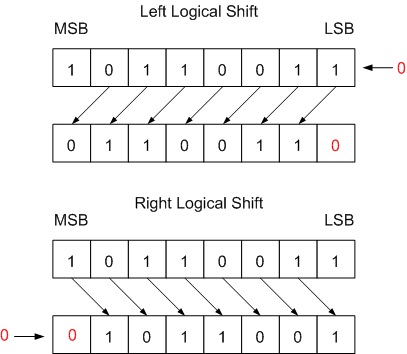Serial 2 S Complementer Shift Register

Arch #11 Computer Architecture Start Lecture #11 Homework: Read 3.1-3-4 3.1: Introduction I have nothing to add. 3.2: Signed and Unsigned Numbers MIPS uses 2s complement (just like 8086) To form the 2s complement (of 0000 1111 0000 1010 0000 0000 1111 1100) • Take the 1s complement. • That is, complement each bit (1111 0000 1111 0101 1111 1111 0000 0011) • Then add 1 (1111 0000 1111 0101 1111 1111 0000 0100) Need comparisons for signed and unsigned. • For signed a leading 1 is smaller (negative) than a leading 0 • For unsigned a leading 1 is larger than a leading 0 Comments on Two's Complement You could easily ask what does this funny notation have to do with negative numbers. Let me make a few comments. • What does minus 1 mean?
Design a serial 2s complementer with a shift register and a design a serial 2's complementer with a shift register and a flip flop. The binary number is shifted out from one side and it's 2's complementer shifted in to the other side of the shift register. The input to the D-type is made up from the initial output (Q) which is OR'd with the. In binary this would be 00011100 To change this to its 2's compliment we.

Ans: It is the unique number that, when added to 1, gives zero. • The binary number 1111.1111 has this property (using regular n-bit addition and discarding the carry-out) so we do seem to have -1 correct. • Just as n+1 (for n≥0) is defined as the successor of n, -(n+1) is the number that has -n as successor. That is we need to show that TwosComp(n+1) + 1 = TwosComp(n). • This would follow if we coud show OnesComp(n+1) + 1 = OnesComp(n), i.e, (n+1)' + 1 = n'. • Let n be even, n = *0, * arbitrary.
• Write n', n+1 and (n+1)' and see that it works. • Let n be odd, n = *01 s1, where 1 s just means a bunch of ones. • Again it works. • So for example TwosComp(6)+1=TwosComp(5) and hence TwosComp(6)+6=zero, so it really is -6. Sltu and sltiu Like slt and slti but the comparison is unsigned. Homework: 3.1-3.6 3.3: Addition and subtraction To add two (signed) numbers just add them.
That is, don't treat the sign bit special. To subtract A-B, just take the 2s complement of B and add. Screen resolution manager. An overflow occurs when the result of an operation cannot be represented with the available hardware. For MIPS this means when the result does not fit in a 32-bit word. • We have 31 bits plus a sign bit. • The result would definitely fit in 33 bits (32 plus sign) • The hardware simply discards the carry out of the top (sign) bit • This is not wrong--consider -1 + -1 11 (32 ones is -1) + 11 ---------------------------------- 110 Now discard the carry out 10 this is -2 • The bottom 31 bits are always correct. Overflow occurs when the 32 (sign) bit is set to a value and not the sign.
• Here are the conditions for overflow Operation Operand A Operand B Result A+B ≥ 0 ≥ 0 64 multiplier. What about the control?
• Always give the ALU the ADD operation • Always send a 1 to the multiplicand to shift left • Always send a 1 to the multiplier to shift right • Pretty boring so far but • Send a 1 to write line in product if and only if LOB multiplier is a 1 • I.e. Send LOB to write line • I.e. It really is pretty boring This works! But, when compared to the better solutions to come, is wasteful of resourses and hence is • slower • hotter • bigger • all these are bad An Improved Circuit The product register must be 64 bits since the product can contain 64 bits. Why is multiplicand register 64 bits? • So that we can shift it left • I.e., for our convenience. By this I mean it is not required by the problem specification, but only by the solution method chosen.